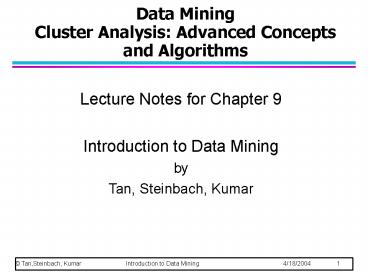Data Mining Cluster Analysis: Advanced Concepts and Algorithms PowerPoint PPT Presentation
1 / 13
Title: Data Mining Cluster Analysis: Advanced Concepts and Algorithms
1
Data MiningCluster Analysis Advanced Concepts
and Algorithms
- Lecture Notes for Chapter 9
- Introduction to Data Mining
- by
- Tan, Steinbach, Kumar
2
Graph-Based Clustering
- Graph-Based clustering uses the proximity graph
- Start with the proximity matrix
- Consider each point as a node in a graph
- Each edge between two nodes has a weight which is
the proximity between the two points - Initially the proximity graph is fully connected
- MIN (single-link) and MAX (complete-link) can be
viewed as starting with this graph - In the simplest case, clusters are connected
components in the graph.
3
(No Transcript)
4
Graph-Based Clustering Sparsification
- The amount of data that needs to be processed is
drastically reduced - Sparsification can eliminate more than 99 of the
entries in a proximity matrix - The amount of time required to cluster the data
is drastically reduced - The size of the problems that can be handled is
increased
5
Graph-Based Clustering Sparsification
- Clustering may work better
- Sparsification techniques keep the connections to
the most similar (nearest) neighbors of a point
while breaking the connections to less similar
points. - The nearest neighbors of a point tend to belong
to the same class as the point itself. - This reduces the impact of noise and outliers and
sharpens the distinction between clusters. - Sparsification facilitates the use of graph
partitioning algorithms (or algorithms based on
graph partitioning algorithms. - Chameleon and Hypergraph-based Clustering
6
Sparsification in the Clustering Process
7
Shared Near Neighbor Approach
SNN graph the weight of an edge is the number of
shared neighbors between vertices given that the
vertices are connected
8
Creating the SNN Graph
Sparse Graph Link weights are similarities
between neighboring points
Shared Near Neighbor Graph Link weights are
number of Shared Nearest Neighbors
9
SNN Clustering Algorithm
- Compute the similarity matrixThis corresponds to
a similarity graph with data points for nodes and
edges whose weights are the similarities between
data points - Sparsify the similarity matrix by keeping only
the k most similar neighborsThis corresponds to
only keeping the k strongest links of the
similarity graph - Construct the shared nearest neighbor graph from
the sparsified similarity matrix. At this point,
we could apply a similarity threshold and find
the connected components to obtain the clusters
(Jarvis-Patrick algorithm) - Find the SNN density of each Point.Using a user
specified parameters, Eps, find the number points
that have an SNN similarity of Eps or greater to
each point. This is the SNN density of the point
10
SNN Density
a) All Points b) High SNN
Density
c) Medium SNN Density d) Low SNN Density
11
SNN Clustering Can Handle Differing Densities
SNN Clustering
Original Points
12
SNN Clustering Can Handle Other Difficult
Situations
13
Features and Limitations of SNN Clustering
- Complexity of SNN Clustering is high
- O( n time to find numbers of neighbor within
Eps) - In worst case, this is O(n2)
- For lower dimensions, there are more efficient
ways to find the nearest neighbors - R Tree
- k-d Trees

